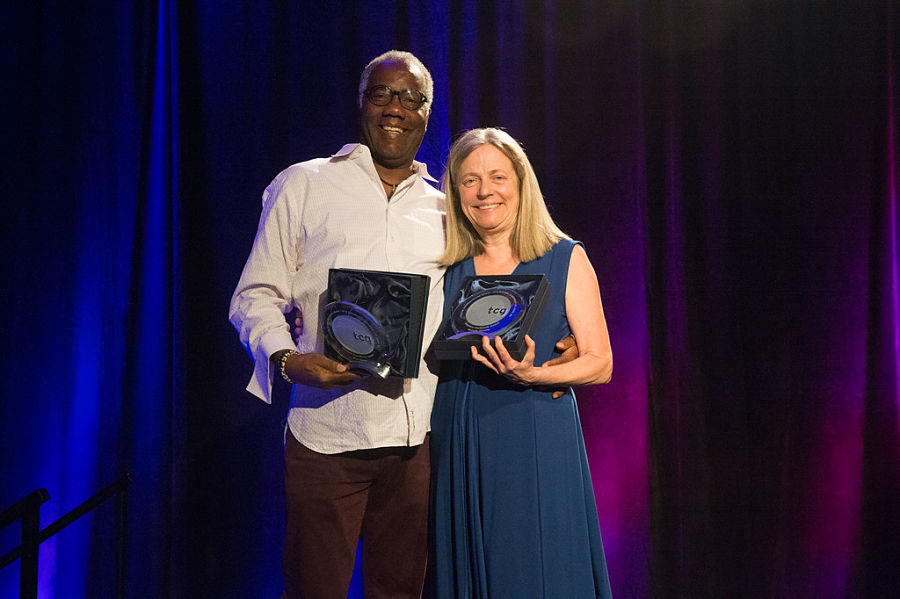ST. LOUIS: “I always thought that one day I would share this data point with my grandchildren,” said Jer Thorp, data artist and speaker at #TCG18’s Friday morning plenary, about the geo-tracking dot, since mined from his iPhone, that marks the fateful moment he met the woman who is now his partner and the mother of his young son. The line got a laugh from the crowd of theatremakers and administrators, which Thorp happily accepted before he pushed back. “Is this really so much different than showing them a photo, to give them something to show we existed?”
The question resonated forward and back through the morning session, which also honored two significant makers of the ephemeral art of performance, founding artistic directors both: St. Louis Black Rep’s Ron Himes, who took home a TCG Theatre Practitioner Award, and Ten Thousand Things’ Michelle Hensley, who received the Visionary Leadership Award. These prizes, like one given to Steven Woolf the night before, honored rich legacies etched into people’s lived experiences and relationships, not into stone or vinyl or paper. Their work consists and persists in ongoing practice, not in any single achievement. As Himes put it in his remarks, looking back as well as forward to a career creating opportunities for black artists to work and be seen, “Our stories are American stories. We will be here as long as the American theatre is here.” Or, in Hensley’s words, “Story is the thread that connects us.”
She followed that with a significant caveat, though: “But a lot of the stories we tell in the theatre are written for people who sit on cushions of wealth, and they’re not that interesting to people who don’t.” She would know: Her Minneapolis-based company is known for taking its minimally designed, multiculturally cast adapted classics—comedies, tragedies, musicals—to audiences of all classes and backgrounds wherever they are, whether in prisons, homeless shelters, or small rural towns. And her vision of inclusion is not theoretical; she talks about her audiences as trusted collaborators, and in fact she began her remarks by thanking them for giving her and her company “the joy of performing for audiences who do not watch with critical distance and aesthetic judgment, but who leap with us into what the stories have to show them and say about their lives. Once you perform them, you never want to go back.” Her bottom line: She wants “everyone to be able to see themselves onstage from the first time they go to the theatre.”

Himes, for his part, defined the mission of his historic theatre of color, founded in 1976 as one of the first black theatres in St. Louis, as “telling American stories from an African American perspective.” An actor as well as a director, Himes has been driving almost daily from Evansville, Ind., where he’s appearing as Senator Norval Hedges in New Harmony Theatre’s production of Born Yesterday.
The bearded and bespectacled Thorp, dressed in black jeans, sport coat, and vintage Bruce Springsteen T-shirt, spends his days finding ways to tell stories with data, and one form his work has taken has been theatrical: In a collaboration with New York City’s Elevator Repair Service on a project with the Museum of Modern Art that mined a database of artist’s names and artwork titles for an inspired, loopy linguistic happening at MOMA titled A Sort of Joy (Thousands of Exhausted Things).
Another project he’s helped lead in St. Louis itself is something called the Map Room, which took over an abandoned public school and hosted groups to draw maps of their own experiences in the city, then watch as layers of “civic data” were was overlaid on their handmade cartography. The confluences and contrasts that emerged from these map layers—historic “redlining” maps that reified black/white segregation vs. the places a group of present-day St. Louis students feels safe and happy, for instance—told stories of entrenched injustice but also opened up new possibilities, Thorp said, to tell different stories. As he put it, “Map Room is an instrument for revisioning how urban societal change can happen.” The project has announced dates in several other U.S. cities.
“What is it like to live in data?” was the central question of his talk. Neither a tech utopian nor an apocalyptic anti-tech guru, Thorp—who teaches at New York University and is the Library of Congress’s “innovator in residence”—promulgates what he calls “data humanism,” which aims to give us all more ownership over the personal data we now generate with our devices, the same data that tech companies, advertising firms, not to mention state actors, are all too eager to claim if we don’t. Citing the great urbanist Jane Jacobs, Thorp compared the headlong development of technology to that of modern cities. “We’ve created marvels,” Jacobs once wrote of cities, her great subject, “but we left out feedback. What can we do with cities to make up for this omission?” Likewise, tech is “building these gigantic systems with no way to report back on them.”
Theatre and art may have a crucial role to play in that feedback and rehumanization, whether it’s about reclaiming our data or fighting other oppressive forces that disproportionately affect vulnerable populations. One teacher whose students had a transformative experience at the St. Louis Map Room might have been describing the work of St. Louis Black Rep or in particular Ten Thousand Things when she said that the project taught her young charges that “art is larger than what is inside these four walls.”


